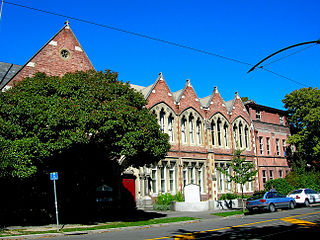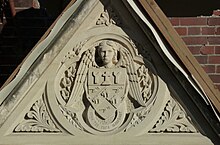Cranmer Centre
| Cranmer Centre | |
|---|---|
 Cranmer Centre, 2009 | |
Location within the Christchurch Central City | |
| Former names | Christchurch Girls' High School |
| General information | |
| Type | Former school |
| Architectural style | Venetian Gothic architecture |
| Location | Christchurch Central City |
| Address | 40 Armagh Street |
| Town or city | Christchurch |
| Country | New Zealand |
| Coordinates | 43°31′44″S 172°37′48″E / 43.52889°S 172.63000°E |
| Completed | September 1881 |
| Destroyed | May 2011 |
| Owner | Arts Centre of Christchurch Trust |
| Technical details | |
| Floor count | three |
| Design and construction | |
| Architect(s) | William Barnett Armson |
| Main contractor | Greig and Hunter |
| Renovating team | |
| Architect(s) | Collins and Harman |
| Designated | 24 February 1994 |
| Reference no. | 1849 |
| References | |
| "Cranmer Centre". New Zealand Heritage List/Rārangi Kōrero. Heritage New Zealand. Retrieved 23 May 2011. | |
The Cranmer Centre (originally: Christchurch Girls' High School) was a historic building in Christchurch, New Zealand. Its original use, until 1986, was as the Christchurch Girls' High School, the second high school for girls in the country. Registered with the New Zealand Historic Places Trust as a Category I heritage building, it was purchased by Arts Centre of Christchurch Trust in 2001, and demolished in May 2011 following the February 2011 Christchurch earthquake.
Geography[edit]

The centre was located on the south-west corner of Armagh and Montreal Streets by Cranmer Square.[1] On the opposite side was the Christchurch Normal School, later renamed Cranmer Court.[2] The Christchurch heritage tram passed the building on its central city circuit along Armagh Street.[3]
History[edit]

The Cranmer Centre is named after Cranmer Square, which takes its name from Thomas Cranmer, a noted Protestant reformer who shaped the Church of England, and wrote the first edition of the Book of Common Prayer.[4]
Christchurch Girls' High, the second high school for girls in New Zealand, was established in 1877.[1] It was preceded by Otago Girls' High School, which is believed to be the oldest secondary girls' school in the Southern Hemisphere.[5] After a year in temporary accommodation, the girls school moved into new premises on the corner of Hereford Street and Rolleston Avenue designed by Thomas Cane (1830–1905), immediately adjacent to the Canterbury College. That building is these days part of the Arts Centre.[1]
Cane's building soon ran out of room, and William Barnett Armson, who had previously been employed by the provincial council, was commissioned to design a new building in 1879.[1] It is believed that Armson carried out the design work in 1880[6] and it was built the following year by the firm of Greig and Hunter. The school opened in September 1881.[7]
Additions and renovations were made in 1907 and 1912 by Collins and Harman. Subsequent additions and alterations in 1936–1941 and 1961 were by Collins Architects.[1]


After the Girls' High School moved to its new site in Deans Avenue in 1986, the old building was leased to the Arts Centre of Christchurch Trust on a long-term lease and used for arts, cultural, social service and community groups. The Crown sold the land and buildings to Ngāi Tahu, and in 2001, it was sold to the Arts Centre of Christchurch Trust.[8]
The building was registered under the Historic Places Act 1980, and on 24 February 1994, the structure became registered (No. 1849) with the New Zealand Historic Places Trust as a Category I heritage building.[1]
Following the 2011 Christchurch earthquake, the building was damaged and found to contain the toxic substance asbestos.[9] It was demolished in May 2011; all that was remaining for a while was the main entrance portal on Armagh Street, but this was removed some weeks later.
Architecture[edit]

The building was of Venetian Gothic architecture. Concrete foundations and brick masonry walls were used in the original construction as well as the additions of 1907 and 1912. External and internal walls are of brick. The windows had sandstone facing features. The roof was characterised by timber sarking and slate sheathing. Roofing over the hall/library was replaced in 1989 after a fire.[1]
As part of the 1907 addition, the gabled entrance was relocated to the east end of the new building, while it was originally located at the northeast porch area. The entrance has Corinthian pilasters[1] and displays the original crest of Canterbury College above the architrave, demonstrating the links that the school had with the university at its previous site. The crest is inscribed "Ergo tua rura manebunt", meaning "therefore may your fields prosper"; this refers to the then extensive landholdings that the college had been given by the provincial government that were earning it an income.[10]
One of the building's notable feature had been constructural polychromy.[1]
Notable people[edit]
Helen Macmillan Brown (née Connon; wife of John Macmillan Brown), the second woman to graduate from a British university, was Principal of Christchurch Girls' High School from 1882 to 1894.[11]
Two students of the school, Juliet Hulme and Pauline Parker, made world news in 1954 when they killed Pauline's mother in Victoria Park. The murder became the basis of several works of literature and film. The most famous of these is Peter Jackson's 1994 film Heavenly Creatures.[12][13]
References[edit]
- ^ a b c d e f g h i Lovell-Smith, Melanie (8 December 2001). "Cranmer Centre (Former Christchurch Girls High)". New Zealand Historic Places Trust Pouhere Taonga. Retrieved 20 May 2011.
- ^ Shepard, Deborah; Gillian Hay; R.D. Johnson; J.M. Densem; P.M. Shapcott (October 1986). "THE ARCHITECTURAL HERITAGE CHRISTCHURCH" (PDF). CHRISTCHURCH CITY COUNCIL TOW PLANNING DIVISION. p. 3. Retrieved 22 May 2011.
- ^ "Tram Tour". Tram Christchurch. Retrieved 22 May 2011.
- ^ Evangelical magazine and missionary chronicle. 1863. pp. 442, 791–.
- ^ "Otago Girls' High School Main Block". New Zealand Heritage List/Rārangi Kōrero. Heritage New Zealand. Retrieved 23 May 2011.
- ^ "City of Gothic Proportions" (PDF). New Zealand Historic Places Trust Pouhere Taonga; Christchurch City Council. p. 1. Archived from the original (PDF) on 9 October 2011. Retrieved 20 May 2011.
- ^ "Christchurch Girls' High School, showing the new extension on the left (1913)". christchurchcitylibraries.com. Retrieved 22 May 2011.
- ^ Robson, Matt (18 July 2001). "Arts Centre to purchase old Girls High". beehive.govt.nz. Retrieved 22 May 2011.
- ^ "Asbestos found in 12 Christchurch buildings damaged by earthquake". Asbestos News. 22 April 2011. Retrieved 20 May 2011.
- ^ "History of the Coat of Arms". University of Canterbury. Archived from the original on 18 February 2013. Retrieved 26 May 2011.
- ^ Edited by A. H. McLintock (22 April 2009). "BROWN, Helen Macmillan". Te Ara – the Encyclopedia of New Zealand. Retrieved 22 May 2011.
{{cite web}}:|last=has generic name (help) - ^ "We were not lesbians, says former Juliet Hulme". The New Zealand Herald. 5 March 2006. Retrieved 20 May 2011.
- ^ "Pauline Parker". Ministry for Culture and Heritage. 22 June 2010. Retrieved 20 May 2011.
External links[edit]
![]() Media related to Cranmer Centre at Wikimedia Commons
Media related to Cranmer Centre at Wikimedia Commons
- School buildings completed in 1881
- Buildings and structures in Christchurch
- Former school buildings in New Zealand
- Community centres in New Zealand
- Heritage New Zealand Category 1 historic places in Canterbury, New Zealand
- Christchurch Central City
- Buildings and structures demolished as a result of the 2011 Christchurch earthquake
- 1880s architecture in New Zealand
- 1881 establishments in New Zealand
- Buildings and structures demolished in 2011

